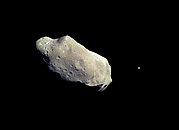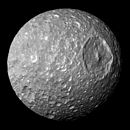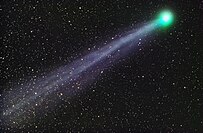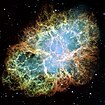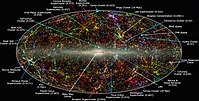An astronomical object, celestial object, stellar object or heavenly body is a naturally occurring physical entity, association, or structure that exists within the observable universe.[1] In astronomy, the terms object and body are often used interchangeably. However, an astronomical body or celestial body is a single, tightly bound, contiguous entity, while an astronomical or celestial object is a complex, less cohesively bound structure, which may consist of multiple bodies or even other objects with substructures.
Examples of astronomical objects include planetary systems, star clusters, nebulae, and galaxies, while asteroids, moons, planets, and stars are astronomical bodies. A comet may be identified as both a body and an object: It is a body when referring to the frozen nucleus of ice and dust, and an object when describing the entire comet with its diffuse coma and tail.
- ^ Task Group on Astronomical Designations from IAU Commission 5 (April 2008). "Naming Astronomical Objects". International Astronomical Union (IAU). Archived from the original on 2 August 2010. Retrieved 4 July 2010.
{{cite web}}: CS1 maint: numeric names: authors list (link)
